From high-end Michelin-starred restaurants to hip cafes to restaurant chains, there are plenty of food choices in Singapore. But if you want affordable and authentic local cuisines, head over to hawker centres instead.
At hawker centre, you will find so many choices of food, from traditional to fusion. The price of hawker food generally starts from SGD 3 onwards. Most food are priced within SGD 3 to 10, although specialty stalls (seafood, steaks, tze char) will charge a higher price.
Even though English is widely spoken in Singapore, sometimes it can prove challenging to order food correctly at hawker stall.
I still remember an awkward encounter that I faced in my early years of living in Singapore. Right after I ordered my food, the seller asked me, “Eat?” I froze in confusion and didn’t know what to answer. I was thinking, of course I am going to eat the food myself, not drink it or give it to someone else, why would he ask me this weird question.
The seller impatiently asked again, “Eat?” I nodded hesitantly. Later, after discussing with my friends, I finally understood that the seller was asking whether I wanted to eat there or take away my food.
To save you from embarrassment for not understanding local slang, or for being stared annoyedly by food sellers because they can’t understand you, here is my guide on how to order hawker food like a local in Singapore.
I’ll also share pro-tips on how to customize your food. Customization is optional; most sellers allow customization but some sellers do not. Sit back and hope you enjoy my guide!
Looking for ideas on what to do in Singapore? Here’s my guide on the best things to do in Singapore.
Eat vs Packet/Dabao
First, let’s address the most important question that you will encounter at hawker centre.
When you are at a hawker stall, ready to order, the first question they’ll most likely ask you is, “Eat?” or “Having here?” Both questions imply, “Are you eating here?” If you are, you can say yes.
If you’re getting a takeaway/takeout/to-go, simply tell them, “Takeaway” or “Dabao” or “Packet”
Some hawkers may not understand takeout or to-go, so I’ll recommend sticking to the commonly used phrases in bold.
Your order may be subjected to additional takeaway fee (about 30 cents) to account for the box that’s used to store the food. If you bring your own box/container, this takeaway fee will not be charged.
Useful Tips When Eating at Hawker Centres
As hawker centres adopt free-seating and self-service system, you need to find your own seat and purchase the food yourself. If you’re a solo traveller, the only way to “reserve a seat” in a crowded food market is by putting your worthless belongings (e.g. a pack of tissue, an umbrella) on a table before buying your food. It’s universally acknowledged that seats with personal belongings are reserved seats.
Try to decide what to order before you arrive at the front of the queue, to save everyone’s time and to avoid being scolded by impatient sellers.
Bring your own tissue and/or wet wipes. These will come in handy when you encounter dirty tables in hawker centres.
Card payments are not widely accepted yet, but cash and online payments (eg: grabpay, paynow, paylah, amex pay, shopee pay, shopback, etc) are gradually being accepted by more and more sellers.
After finishing your meal, do clear your table and bring them to the tray collection point. It is mandated by law.
Now, let’s dig into the food! Ordering, I mean!
Chicken Rice
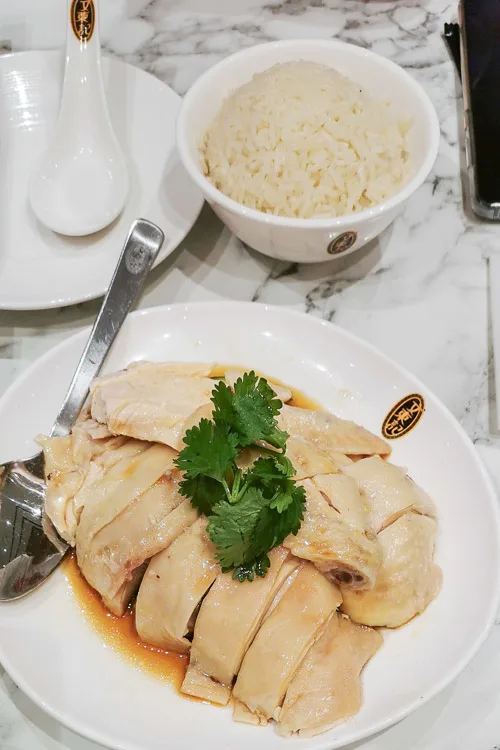
Have any questions about traveling in Singapore? Join All About Singapore Travel FB group, I'll be there to answer your questions!
Chicken rice refers to a plate of fragrant rice served with poached chicken (also called white chicken), bean sprouts, cucumber and soup. If you prefer certain parts of the chicken, such as breast, thigh or drumstick (pricier), tell them up front when you order. You can also order a whole chicken or a half chicken.
Some chicken rice stalls also sell roasted chicken rice and soya sauce chicken rice. You can request to combine white, roasted and soya sauce chicken and pay extra for it if you don’t want to miss anything out. Lastly, dip the chicken in red chili sauce and minced garlic.
Default order: Chicken rice refers to a plate of fragrant rice topped with poached chicken, bean sprouts, cucumber and sometimes soup.
How to order:
- Decide if you want individual portion or half chicken/whole chicken.
- For individual portion, it comes with a serving of rice.
- For chicken only, it doesn’t come with rice, so you need to order rice.
- Choose the type: chicken rice, roasted chicken rice or soya sauce chicken rice.
- Tell them your customization, if any.
- While waiting for your food, help yourself to the red chili sauce and minced garlic sauce.
Possible customization:
- If you’re a picky eater, you can tell them the parts that you want (breast, thigh, drumstick). Drumstick may cost more.
- If you’re hungry, you can add extras (eg: extra egg, rice, or vegetables).
- If you have FOMO, you can request a combination (eg: white chicken + roasted chicken).
Laksa
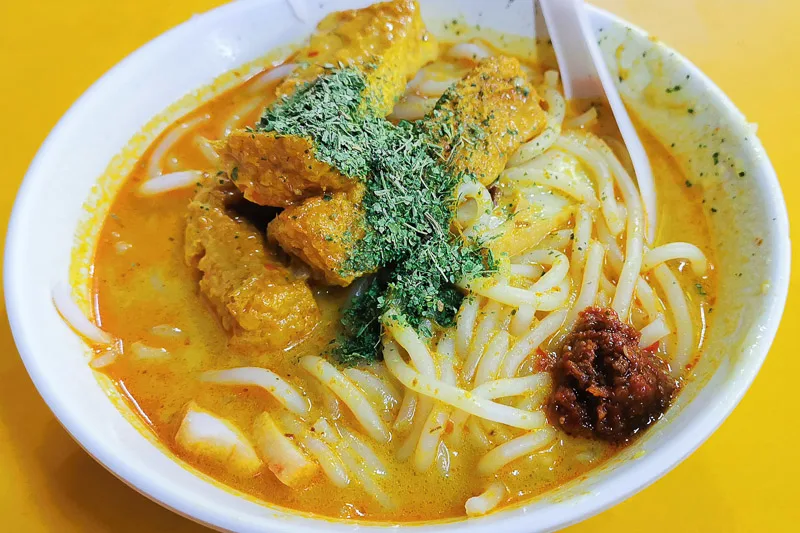
Singapore’s laksa is very different from Malaysia’s and Indonesia’s laksa. Singapore’s laksa is kind of similar to curry, but it is more aromatic and textured. The flavour is savoury and a bit sweet. Many people (including me) prefer to add chili to laksa for more oomph.
Default order: Laksa refers to a bowl of thick vermicelli (beehoon) in coconut-milk-based broth, topped with proteins (usually cockles, prawn, fishcake or chicken), tofu puffs (taupok), beansprout, curry leaves and sometimes egg.
How to order:
- Decide the size of your laksa.
- Decide if you want to add or remove certain ingredients (eg: remove cockles, bean sprout, chili, curry leaves).
- While waiting for your food, help yourself to the chili sauce, if any.
Mushroom Minced Meat Noodle
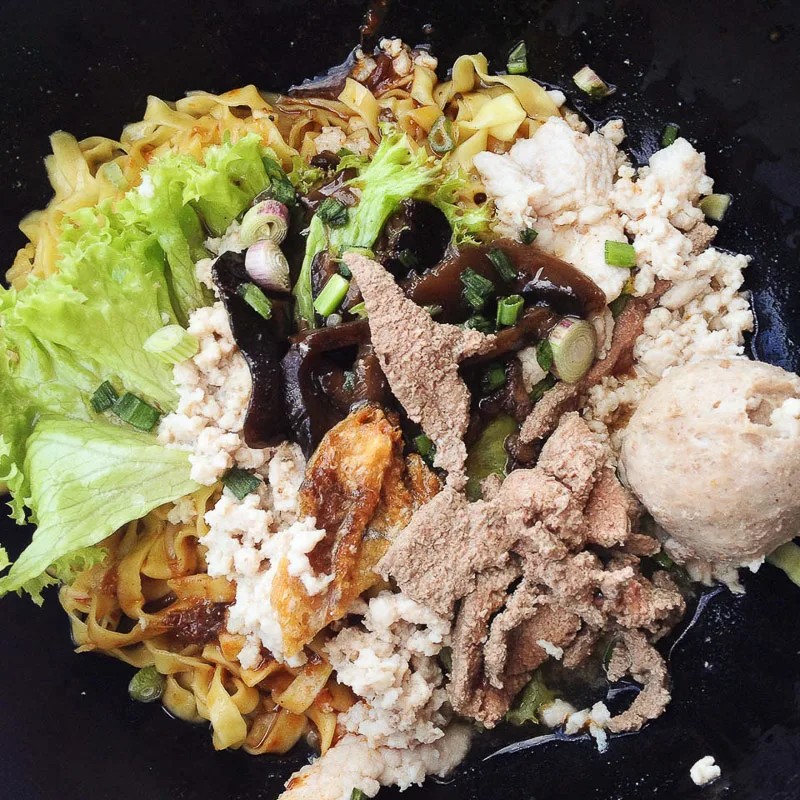
The local name for mushroom minced meat noodle is bak chor mee. The default noodle is mee pok, flat and wide egg noodles.
In the dry version, the noodle is tossed with sauces (chili, oil, vinegar, mushroom sauce, and other ingredients), and served with minced pork, pork slices, pork liver, braised mushroom, lettuce, and sometimes meatballs, bean sprouts, pork lard. The dry bak chor mee comes with a bowl of soup as a side.
In the soup version, the sauces are replaced with soup. All the ingredients remain the same.
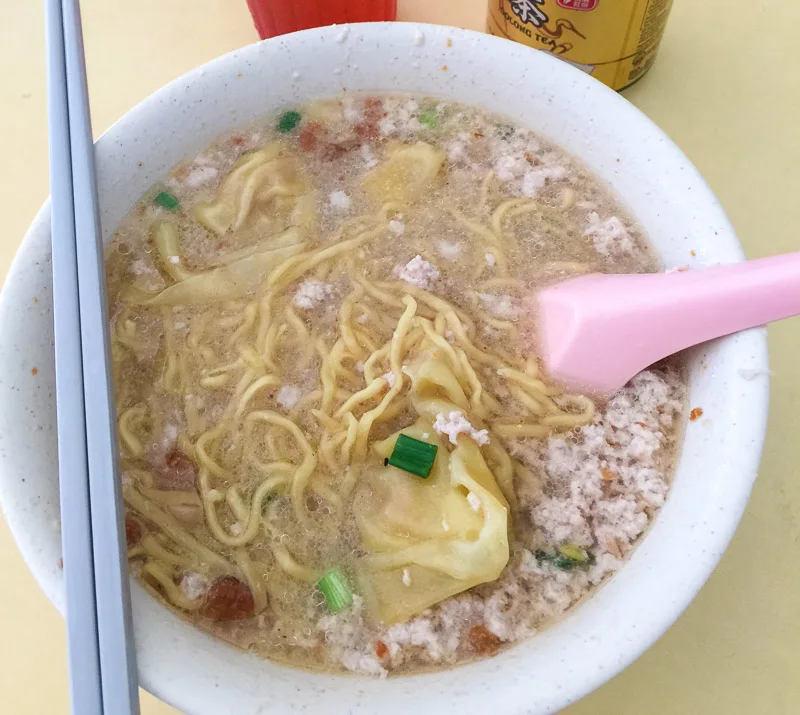
Most bak chor mee stalls sell both options. However, some stalls specialize in only the soup version. If the stall has both options, the rule of thumb is to order the dry version, because these stalls usually pride themselves in creating a great sauce, and they’d would place less emphasis on creating great soup.
Another variation of this dish is fish ball noodle, where the pork slices, meatballs and mushroom are replaced with fish balls and fish cakes.
How to order:
- Choose either dry or soup version.
- Choose the type of noodle: mee pok (flat wide egg noodle), mee kia (thin egg noodle), kway teow (rice noodle), thick/thin beehoon (vermicelli).
- For dry bak chor mee, choose either spicy or not spicy version.
- Tell them your customization, if any.
- While waiting for your food, help yourself to the chili padi soya sauce.
Possible customization:
- Remove certain ingredients (eg: remove vinegar, liver, chili).
- Add extra ingredients.
- For takeaway, if you order dry bak chor mee, some stalls do not give you the soup. If you want, you need to ask for it.
Wanton Noodle/Wanton Mee
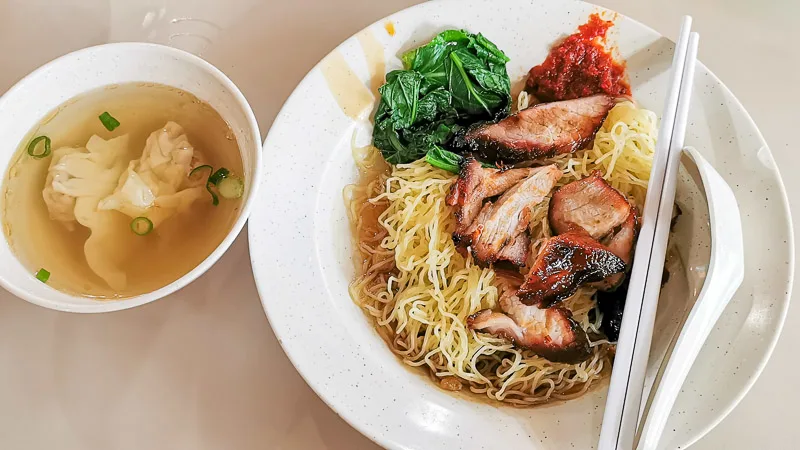
Wanton noodle is present in many Asian countries. Singapore’s wanton noodle is similar to Malaysia’s but different from Hong Kong’s and Indonesia’s.
Wanton means steamed dumpling. Mee means noodle. Wanton mee literally means noodle with dumplings. Most stalls give steamed dumplings, but there are some that give fried dumplings.
Instead of only dumplings, wanton mee in Singapore is topped with chaw siew and vegetable as well. If the stall also sells roasted pork, roasted chicken, or roasted duck, you can customise your noodle with those meats.
Default order:
There are 2 main types of wanton noodle: dry and soup.
Dry wanton noodle refers to springy thin egg noodle tossed with secret sauces and topped with char siew (BBQ pork), vegetables, wanton dumplings, and served with soup on the side.
Soup wanton noodle refers to a noodle soup which comprises thin egg noodle, char siew (BBQ pork), vegetables, and wanton dumplings.
How to order:
- Choose either dry or soup version.
- Choose the type of noodle: mee pok (flat wide egg noodle), mee kia (thin egg noodle), kway teow (rice noodle), thick/thin beehoon (vermicelli).
- For dry wanton noodle, choose either spicy or not spicy version.
- Tell them your customization, if any.
- While waiting for your food, help yourself to the chili sauce.
Possible customization:
- Swap char siew with other protein (eg: roasted chicken, roasted pork, roasted duck, etc), if available.
- Remove certain ingredients (eg: remove vegetable, chili).
- Add extra ingredients.
- For takeaway, if you order dry wanton noodle, some stalls do not give you the soup. If you want, you need to ask for it.
Fish Soup
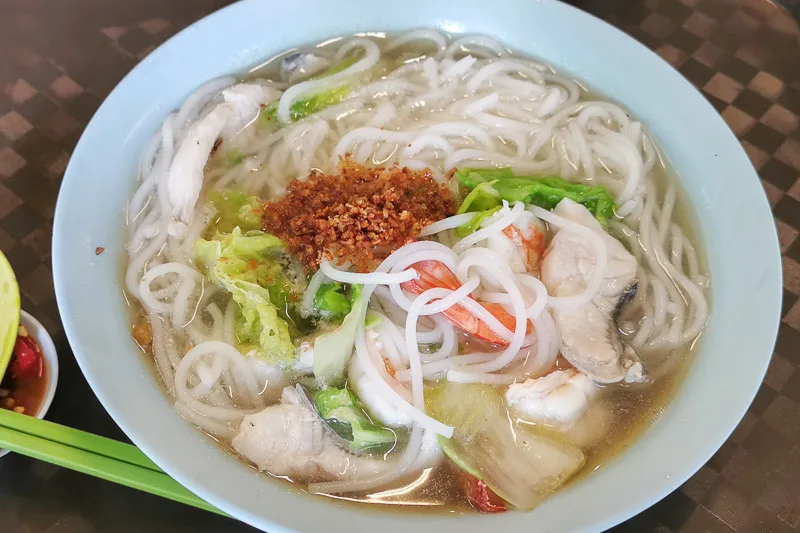
As the name implies, fish (either sliced or fried) is served in piping hot broth together with vegetables and fried shallots. The sliced fish soup is deemed to be the healthier choice compared to other hawker foods.
Default order: Fish soup refers to a bowl of clear, tasty soup with sliced fish, vegetables, tofu, tomato, fried shallot. You need to tell them your preferred carb, otherwise, they’ll serve you a bowl of soup only.
How to order:
- Choose whether you want sliced fish, fried fish, or fish head (or any combination of them).
- Choose the type of carb: steamed rice, thick/thin beehoon (vermicelli), kway teow (rice noodle).
- Choose whether you want milk in your soup.
- Add or remove any ingredients (eg: add prawns, remove vegetables, etc)
- While waiting for your food, help yourself to the chili sauce.
Ban Mian
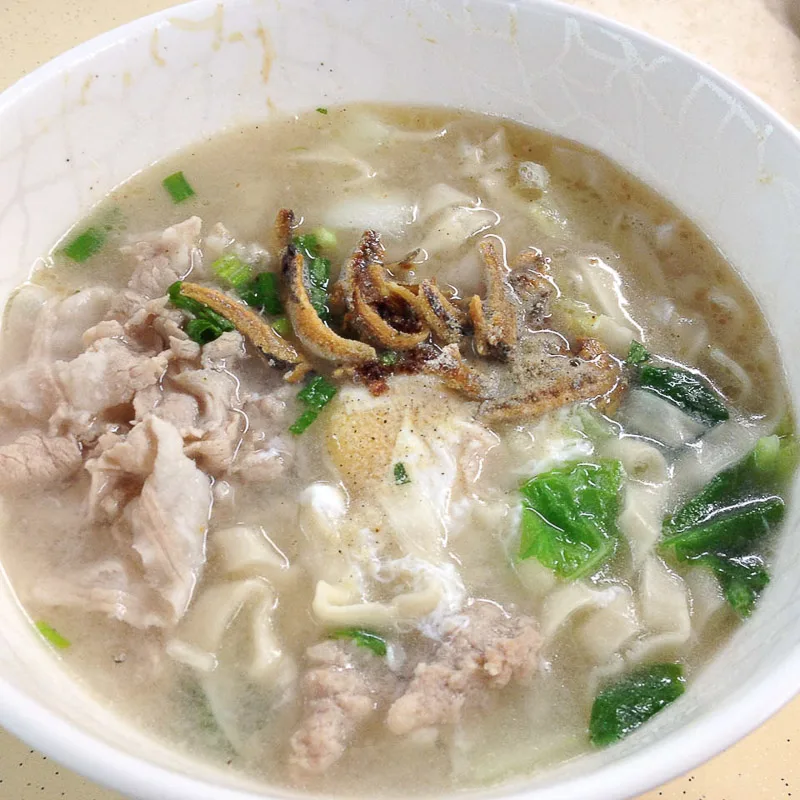
Ban mian literally means a flat handmade noodle. While Malaysia’s people call it Pan Mee, Singapore’s folks call it Ban Mian. When people say ban mian, it refers to the dish, not the noodle.
Default order: Ban mian, as a dish, is a noodle soup that comprises flat noodle, minced pork, vegetables, egg, fried anchovies and fried shallots served in fish/anchovies broth. A raw egg is cracked and thrown in at the end of cooking.
How to order:
- Choose your soup type: original, spicy, tomato, tomyam, etc.
- Choose your noodle: ban mian (flat noodle), you mian (thin noodle), mee hoon kueh (hand-pulled noodle), thick/thin beehoon (vermicelli), kway teow (rice noodle), tang hoon (glass noodle), etc.
- Add/remove ingredients (eg: remove friend shallot, anchovies).
- While waiting for your food, help yourself to the chili sauce.
Carrot Cake
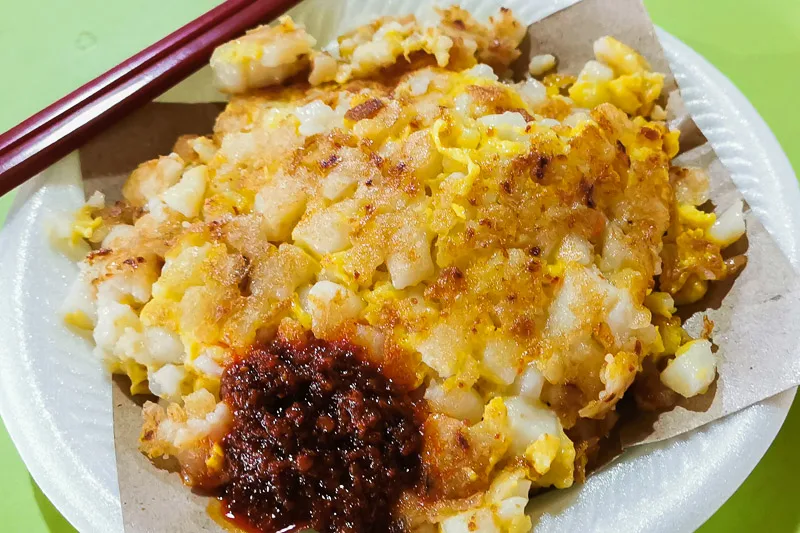
If you’re expecting the western type of carrot cake, you’re in for a surprise. Singapore’s version of carrot cake doesn’t involve a carrot at all.
Instead, it is made of white radish and rice flour, which are shaped into cubes, and then fried with garlic, egg and preserved radish. Then, it’ll be topped with spring onion and added with chili on the side before serving.
There are 2 types: white carrot cake and black carrot cake. The white version is savoury, while the black version is sweet due to the additional dark soya sauce.
Some sellers also offer oyster omelette as well (orh luak) beside carrot cake. If you have FOMO, you can mix and match carrot cake and oyster omelette.
Default order: by default, when you order carrot cake without specifying anything, you’ll be given a plate of white carrot cake in the smallest size.
How to order:
- Choose either the white or black version (or a combination of both).
- Choose the portion size of the carrot cake.
- Add/remove ingredients (eg: add more egg, add chili, remove spring onion, etc).
Char Kway Teow
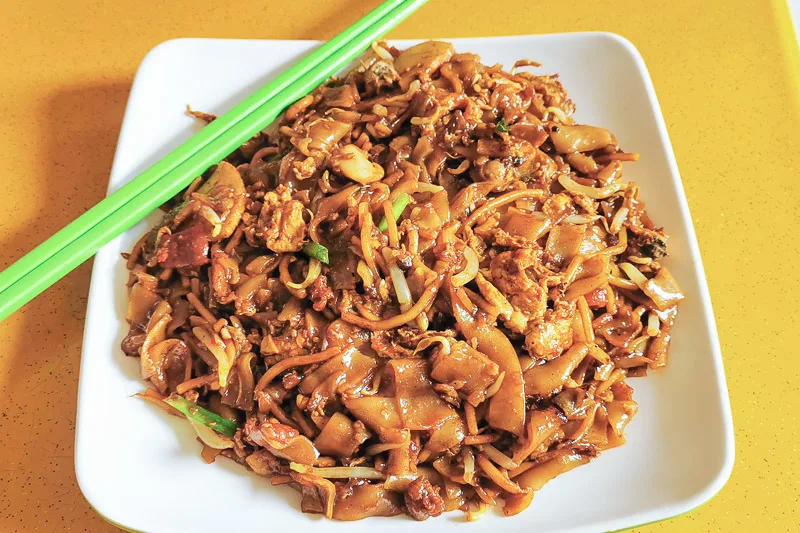
Char means stir-fried, while kway teow means flat rice noodle. There are many variations of char kway teow in different parts of Asia.
In Singapore, char kway teow is flat rice noodle fried with prawns, egg, bean sprouts, vegetables, cockles, sometimes Chinese sausage and lard in the sweet black sauce. The flavour leans more toward sweet than savoury.
There are not many customisations because the dish is quite simple.
How to order:
- Choose the portion size.
- Choose whether you want the spicy or non-spicy version.
- Add/remove ingredients (eg: add more egg, add chili, remove cockles, etc).
Mixed Rice (Cai Fan)
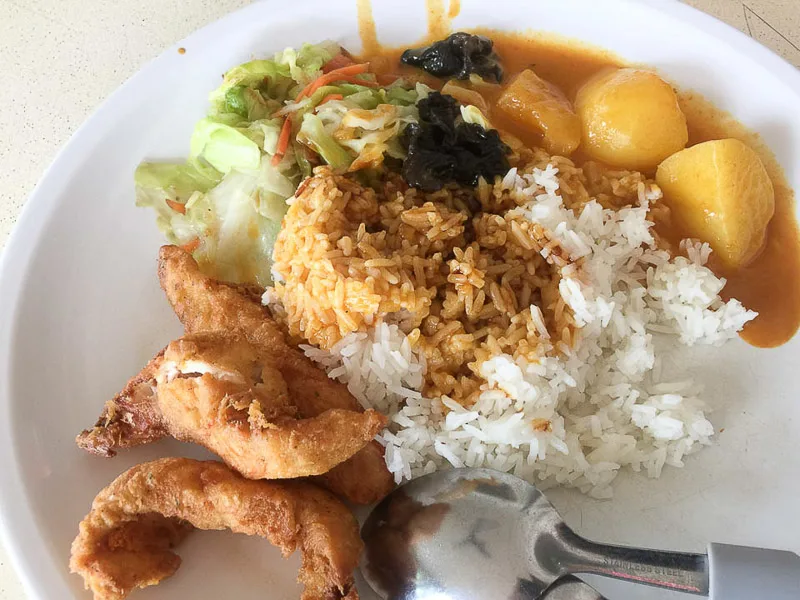
Mixed rice is probably the cheapest meal one can get in a hawker centre. You get to choose your ingredients from a variety of meat and vegetable dishes. The price is calculated based on the number and type of ingredients that you choose.
Cai means vegetable, fan means rice. Cai fan literally means rice with vegetables. But, in reality, cai fan means rice with dishes.
By default, you’ll be given the standard portion of rice (which is usually too big for an Asian woman). You can tell them “less rice” if you don’t eat too much, or “add rice” if you’re hungry.
Try to make up your mind on what to order before queueing, to save time and to save yourself from being scolded by the grumpy seller.
How to order:
- Before the seller scoop the rice, tell him if you are going to “eat” or “take away”.
- Request for “less rice” or “add rice” if necessary.
- Once the seller has scooped the rice, choose your dishes.
- Lastly, you can ask for curry gravy or black gravy if you wish, there’s no additional cost for gravy.
Nasi Lemak
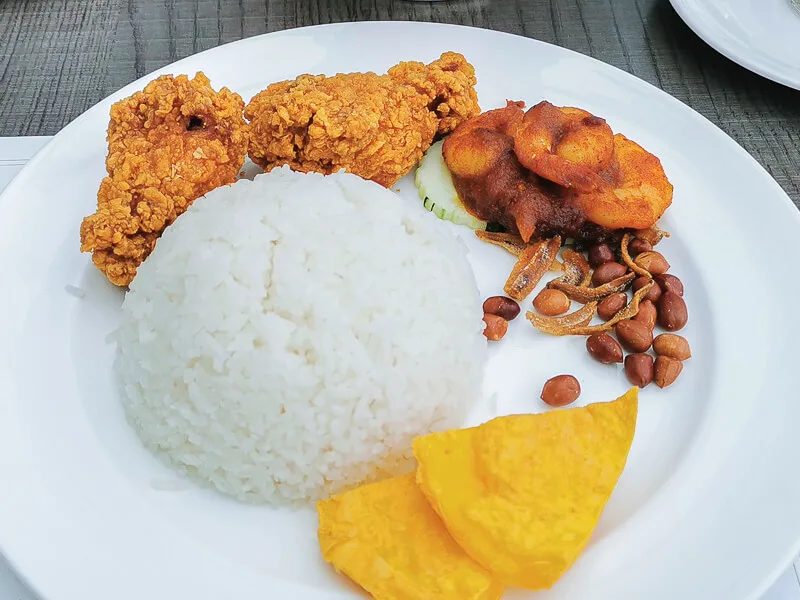
Nasi lemak is simply a plate of fragrant rice (cooked in coconut milk) and served with meat, sambal chili, fried, anchovies, peanuts, fried egg and various fried stuffs.
Most stalls have pre-determined sets that you can choose from. If you’re choosing these sets, you’ll get exactly what’s being shown in the photos. However, some nasi lemak stalls operate like a mixed rice stall, so you’ll be choosing individual dishes that you want.
Default order: Usually, a typical nasi lemak set consists of a plate of coconut-flavoured rice, meat (usually fried chicken wing), fried egg, peanuts, anchovies, cucumber and sambal chili.
How to order:
- Choose whether you want one of the pre-determined sets, or you want ala carte (means choosing the items individually).
- For pre-determined sets, you can add items and just pay extra for that.
- For ala-carte, simply choose the items that you want to accompany your rice.
- Next, proceed for payment. That’s it!
Kaya Toast Breakfast Set
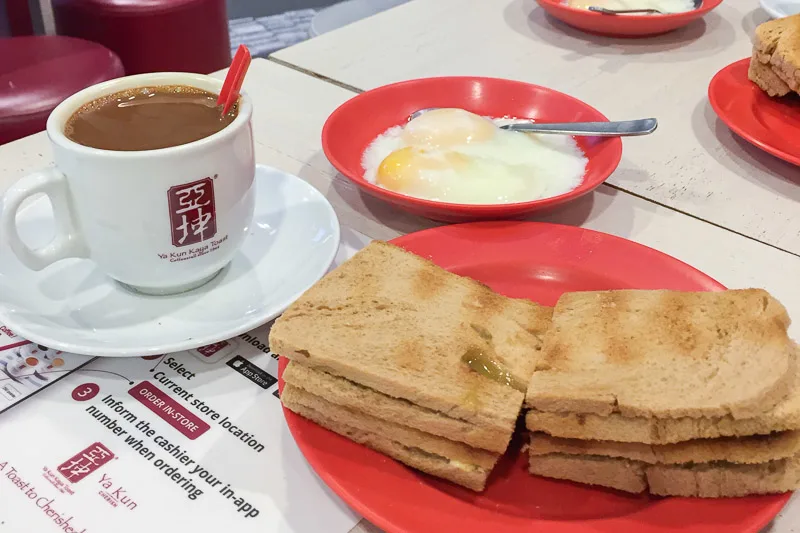
Kaya toast breakfast set is probably a quintessential breakfast in Singapore. It’s cheap, it’s simple and it’s yummy! You can find it in most hawker centre and coffeeshops, it’s usually sold by the drink counter.
It is a light breakfast and usually sold before 11am. Some stalls (like Ya Kun and Toast Box) sell breakfast set all day long.
Most stalls have a pre-determined sets, so usually you just choose the set and tell them your choice of drink.
The most popular toast is kaya toast, but there are plenty of other types of toasts well, such as peanut butter toast, French toast, cheese toast, etc. If you don’t like toast, some stalls can swap the toast with steamed bread.
Default order: A typical breakfast set consists of 3 things: kaya toast (a toast with kaya jam and butter), 2 soft-boiled eggs, and a drink (you can choose tea or coffee).
How to order:
- Choose whether you want a pre-determined set or ala carte.
- For sets, choose your preferred drink.
- For ala carte, choose the items that you want.
- While waiting for your order to be served, get the pepper and soya sauce to season the soft-boiled eggs.
For drinks, there are so many types of tea and coffee in Singapore’s hawker centre. I’ll probably need to write a separate article on how to order a drink in hawker centre.
But for purpose of ordering a breakfast set, here are the most popular drink options:
- Kopi (hot coffee with condensed milk)
- Kopi-o (hot black coffee with sugar)
- Kopi-o kosong (hot black coffee without sugar)
- Teh (hot black tea with condensed milk)
- Teh-o (hot black tea with sugar)
- Teh-o kosong (hot black tea without sugar)
Yong Tau Foo
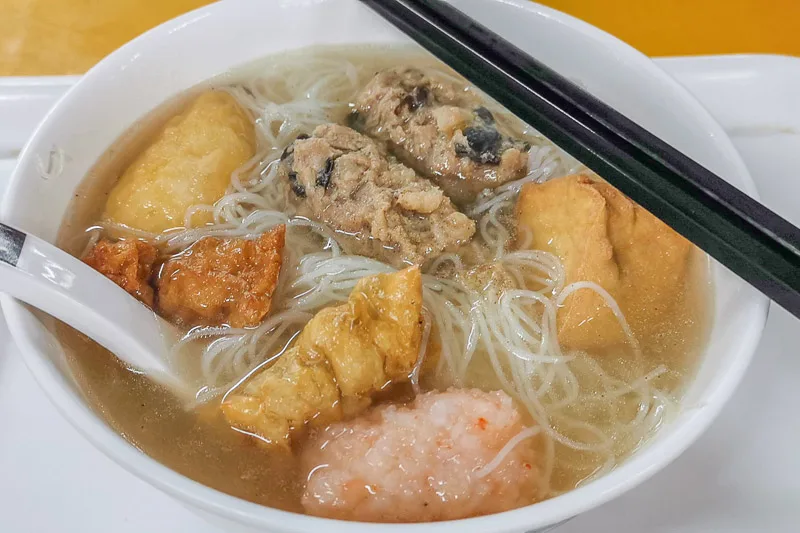
Yong Tau Foo is another healthier food beside fish soup. Traditionally, yong tau foo means tofu stuffed with minced meat, but Singapore has a different take on YTF.
In Singapore, a bowl of yong tau foo is made of a few ingredients that are chosen by the customer, served with rice/noodle and clear soup.
There are 2 types of yong tau foo: dry or soup. In the dry version, the ingredients are tossed with sauce, while the soup is served in a separate bowl. In the soup version, all the ingredients are cooked in the soup. Certain stalls offer other types of soup, such as tom yum, laksa or curry.
Some stalls have pre-determined sets. Other stalls allow full customization. For pre-determined sets, it’s pretty straight forward, you just choose your set and determine your carb.
I will focus more on how to order yong tau foo at stalls that require full customization.
How to order:
- Grab an empty bowl, fill it with your choice of ingredients.
- Pass it to the seller and tell them whether you want a dry version or soup version (and type of soup).
- Then, tell them if you’d like a bowl of rice or noodle (otherwise, no carb will be given). Rice will be served separately, while noodles will be served together in the same bowl as the ingredients.
- Help yourself to the dipping sauces and chili.
Fried Hokkien Mee
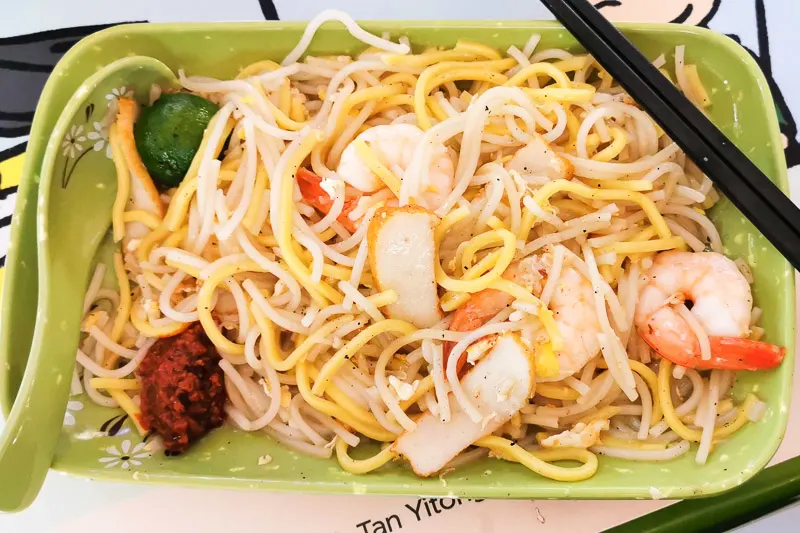
There are many types of Hokkien Mee in various parts of Southeast Asia, and Singapore’s version is unlike those found in other cities.
Singapore’s Hokkien Mee is a plate of goodness where egg noodles and rice noodles are fried with prawns, sometimes squid, egg, bean sprouts, lard and fragrant crustacean broth.
How to order:
- Choose the size that you want.
- Add or remove any ingredients.
- While waiting for your food, help yourself to the chili sauce, if any.
Final Words
So, that concludes my guide on how to order popular food in hawker centers in Singapore! If you’d like to request for advice on how to order other food that I didn’t cover in this article, feel free to let me know in the comment!
For first-timers, hawker centres may be quite an overwhelming experience. They looked dirty and messy. But, I urge you to eat like a local to soak in the unique hawker experience. Pay a visit or two to the hawker centres. Who knows what you will find!
If you like my work, you can buy me a coffee! Your support will help me to keep going!

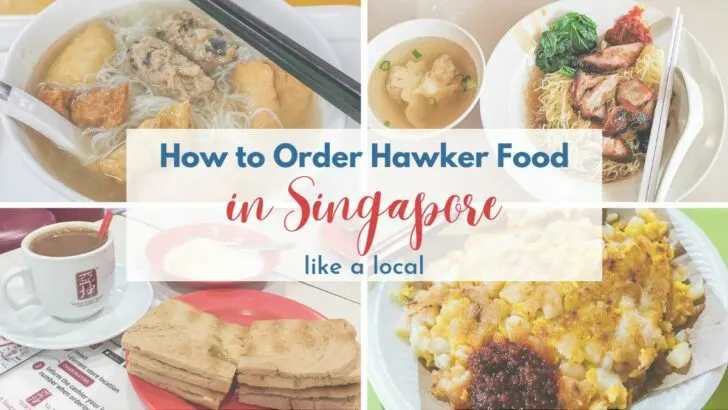
L
Friday 15th of March 2024
Hello Eva, do you know if hawker stall owners are ok with people sharing food. I want to try a lot of places in Singapore, so my strategy is to order the smallest size of one thing and share with one other person, that way we won't get full too fast. Do you think the owners are ok with me asking for an extra set of utensils or plate for sharing? Thank you!
L
Sunday 24th of March 2024
@Eva, Thank you Eva. I just had another question about cockles. When they are served (with laksa or char kway teow), are they served cooked? They seem to have a raw look to them, so I wasn't sure. Thank you!
Eva
Friday 15th of March 2024
Hi L, most of the time, you will be allowed to take the utensils yourself, so you don’t need to request from the stallholders. However, plate is a tricky one. Some sellers don’t allow extra plate, but others gladly provide it to you, so I’d suggest just try asking. If one seller rejects, you can always request from another seller where you’re buying your food from.
Gigi
Tuesday 5th of March 2024
Travelling to Singapore and Kuala Lumpur with a teenage son who is severely allergic to peanuts and tree nuts (cashews, etc). Is there any common local dish that is definitely free of nuts? How can one clearly convey to sellers that the dish must be entirely free of nuts, including nut oils, and be prepared/cooked in clean cookware?
Eva
Tuesday 12th of March 2024
I’m not sure what’s the common food that is definitely free of nuts. Nuts is easy to tell, but nut oils can be quite tough to figure out, so there’s always a risk when you eat at hawker food. As for clean cookware, this is completely out of our control as customer. You can look out for the hygiene sticker pasted on each stall, A means very hygienic while C is not so hygienic. Do you have allergic info card that you can show the seller? Perhaps that can help.
Meg
Tuesday 10th of October 2023
Hi, this a very helpful post for solo travelers, thank you!
I want to try as many new food as possible on my 2 day trip, and I’ll be going solo. What I noticed while researching is most hawker stalls usually sell meals that automatically come with rice, as a set, like chicken/duck rice. I’m feeling I’ll get too full right away if all my orders come with a whole serving of rice. Do I just say “less rice” or “no rice”, or is there a local phrase I can use? I am assuming I’ll still be paying full price and that’s fine with me 🙂
Eva
Wednesday 11th of October 2023
Hi Meg, yes you can say "less rice" or "no rice". For chicken rice, I recommend you opt for less rice, because the rice is fragrant rice and is an integral part of the dish that you don't want to miss :) If you really want to go for "no rice" for chicken/duck/pork, they will serve you bigger meat portion meant for sharing, which is more expensive than the individual portion with rice. It's a common practice that they don't serve individual portion of chicken rice without rice, because the amount of meat is too little.
Bron
Thursday 11th of May 2023
Great article, I really enjoyed it and feel more prepared to enjoy the local foods - thank you
Eva
Friday 12th of May 2023
Thank you! Glad you enjoyed this article =)
Ashish
Wednesday 3rd of May 2023
Hello, Any good hawker recommendations for Laksa (preferably veg)
Eva
Wednesday 3rd of May 2023
Hi Ashish, for vegetarian laksa, you can try greendot (not hawker, though). For hawker, sorry I don't have recommendation for veg laksa.